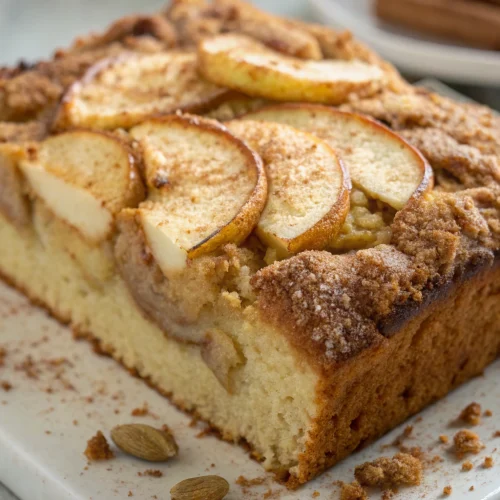
Jewish Apple Cake
This iconic dairy-free Jewish Apple Cake recipe combines time-honored techniques with precise measurements that guarantee success every time. Whether you're preparing for a holiday gathering or simply craving a slice of nostalgic comfort, this apple-forward cake delivers rich flavor without requiring a drop of dairy—making it both traditionally authentic and surprisingly versatile for modern dietary needs.
Equipment
- 10-inch Tube Pan or Bundt Pan
- Electric Mixer
- Mixing Bowls
- Wire Cooling Rack
Ingredients
For the Apple Layer
- 4-5 medium Granny Smith apples about 2 pounds, peeled, cored and thinly sliced
- 2 tablespoons granulated sugar
- 1 tablespoon ground cinnamon
- 1 teaspoon fresh lemon juice prevents browning and adds brightness
For the Cake Batter
- 3 cups all-purpose flour substitute with 1:1 gluten-free flour blend if needed
- 2½ cups granulated sugar
- 1 tablespoon baking powder
- ½ teaspoon salt
- 4 large eggs room temperature
- 1 cup vegetable oil avocado oil works beautifully for a healthier option
- ¼ cup fresh orange juice the secret ingredient that provides moisture without dairy
- 2½ teaspoons pure vanilla extract
- ½ teaspoon almond extract optional but adds wonderful depth
Instructions
- Preheat your oven to 350°F (175°C). Generously grease and flour a 10-inch tube pan or bundt pan, making sure to coat all crevices. For easier release, consider using a non-stick baking spray with flour. Allow eggs and orange juice to reach room temperature for optimal volume in your batter.
- In a medium bowl, combine the peeled and sliced apples with cinnamon, sugar, and lemon juice. Toss gently until all slices are evenly coated. The lemon juice not only prevents browning but adds a subtle brightness that enhances the apple flavor. Set aside to allow the flavors to meld while you prepare the batter.
- In a large bowl, whisk together the flour, baking powder, and salt. This uniform distribution of leavening agents ensures your cake rises evenly. If your flour feels lumpy, consider sifting these ingredients together for an ultra-tender crumb.
- In a separate large bowl, beat the eggs with an electric mixer on medium speed until frothy (approximately 1 minute). Gradually add the sugar while continuing to beat until the mixture becomes pale yellow and slightly thickened—about 2-3 minutes. This creates tiny air pockets that contribute to the cake's perfect texture.
- While mixing on low speed, slowly pour in the vegetable oil, then add the orange juice, vanilla extract, and almond extract (if using). The measured addition of oil creates an emulsion with the eggs that's crucial for moisture retention.
- Gradually fold the flour mixture into the wet ingredients, using a rubber spatula with a gentle hand. Mix just until no dry streaks remain—overmixing activates gluten and can make your cake tough rather than tender.
- Pour one-third of the batter into your prepared pan. Arrange half of the apple slices over the batter, being careful not to let them touch the sides of the pan (this prevents sticking). Repeat with another third of batter and the remaining apples, finishing with a final layer of batter on top.
- Bake in the preheated oven for 70-80 minutes, or until a wooden skewer inserted near the center comes out clean with a few moist crumbs. If the top begins browning too quickly, cover loosely with aluminum foil after the first 45 minutes.
- Allow the cake to cool in the pan for 15 minutes. Then run a knife around the edges and carefully invert onto a wire rack to cool completely. This patience pays off with perfect slice integrity when serving.
Notes
This cake actually improves in flavor after 24 hours as the moisture redistributes.
Store in an airtight container at room temperature for up to 3 days or refrigerate for 5-7 days.
For freezing, wrap individual slices in plastic wrap, then foil, and freeze for up to 3 months. Thaw overnight in the refrigerator.
For a healthier version, you can reduce the sugar by up to 25% or substitute half the oil with unsweetened applesauce.
Nutrition
Calories: 345kcalCarbohydrates: 52gProtein: 3gFat: 14gSaturated Fat: 2gCholesterol: 46mgSodium: 128mgFiber: 1.5gSugar: 36gVitamin C: 4mgIron: 6mg
Tried this recipe?Let us know how it was!